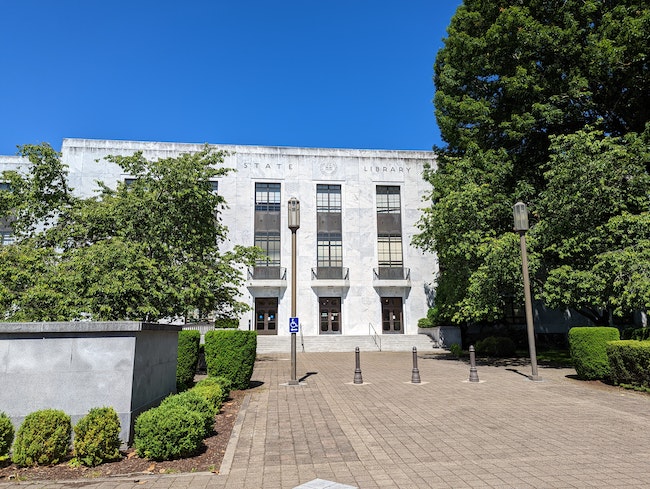
The Oregon State Library as seen from the Capitol Mall (Rachel Alexander/Salem Reporter)
Oregon’s state library is the latest Salem building to earn a spot on the National Register of Historic Places.
In addition to the building’s design significance, the listing is a recognition of the role the library played during the end of the Great Depression as a source of employment for Oregonians during construction and early years of operation.
The building was constructed with funding provided by the Public Works Administration and Works Progress Administration, two New Deal programs intended to provide employment during the Great Depression, according to the state’s nomination letter.
“The State Library was significant during the WPA era for being the only library that served all Oregonians and contributed greatly to education in the state. The library distributed WPA funds to employ somewhere between 120-135 workers to drive bookmobiles, clean and repair books, staff service desks, and do outreach to community organizations. The project lasted through the end of the WPA funding in 1943,” said a Tuesday news release from the state library.
The 1939 building with a white marble exterior is the second on the Capitol Mall to be recognized for its historical significance, following the Capitol itself, the release said. The National Park Service, which maintains the registry, added the library April 21 following a December nomination by the Oregon’s State Advisory Committee on Historic Preservation.
“The building has a rich history dating back to 1938. The land had formerly been used for houses, one of which was the Cooke-Patton House, built by Edwin N. Cooke, Oregon’s first State Treasurer. The house was demolished, and construction began in 1938,” the release said.
The final cost of construction totaled $825,000. Before getting its own building, the state library had been housed with the Supreme Court.
“The library served as a reference library for state officials, legislators and boards. In addition, its traveling libraries provided fifteen remote locations with education and entertainment. When the new library building opened, it was the only library available to 284,000 of Oregon’s approximately one million residents,” the nomination said.
Properties listed on the national registry are recognized for their significance to the nation, state or local community and may be eligible for tax benefits and grant funds.
-Rachel Alexander









